Frequently asked questions and answers for Safety Sensors - Industrial Automation
What is the muting function?
Muting Function
The muting function temporarily disables the safety function when a workpiece or conveying palette passes through the detection area of Safety Light Curtains or Safety Sensors.
F3SN/F3SL-series Safety Light Curtains and F3SH-series Multi-beam Safety Sensors do not have a muting function, but the muting function can be used if F3SP-U2P Muting Controller for Safety Sensors (sold separately) is used in conjunction with these products. Refer to the following application example.
Example Application Using the Muting Function by Combining an F3SN with an F3SP-U2P
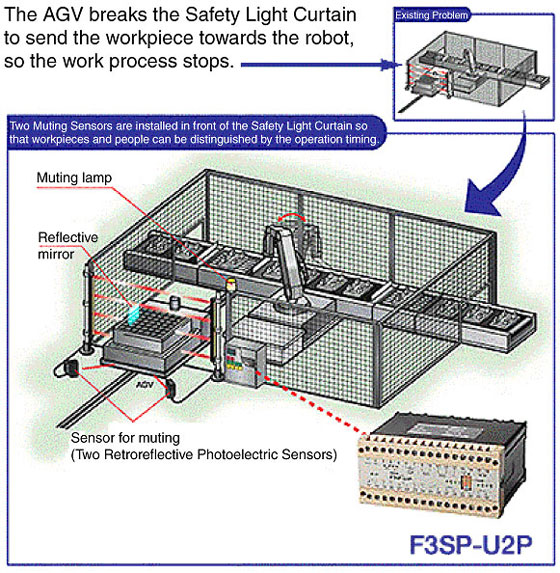

Notes
The F3SP-U2P Muting Controller distinguishes between workpieces and people passing through by the timing of the detection by Muting Sensors A and B.
Adjust where Muting Sensors A and B are installed and the sensing direction so that the passage of a person does not interrupt the beams from both Sensors.
Why does the Short-range Safety Light Curtain "F3SN/F3SH" employ the PNP output?
In the case when equipment is connected to a common earth ground (0V), the PNP output is used to prevent an output malfunction due to earth fault.
Therefore, Safety Sensors/ Safety Light Curtains designed for safe use employ the PNP output for ensuring the safety of customers.

* If the side of 24VDC is grounded, safety is ensured.
When using the NPN output, if a coating of output lines peels off and they are touching the frame of facilities, a hazardous source keeps existing and uncontrollable. It is very dangerous. Burnout of the coating and short circuit to the frame occur at an extremely high ratio.
If output lines are short-circuited, loads are stopped without running away because any voltage is not applied to them. It is very safe.
However, the system connected to 24VDC ground can also use equipment with NPN output, thus NPN output type models are also available for the F3SN-B Series.
What is a self test?
The self test function checks for errors in Safety Sensors. Self testing occurs when the power is turned ON (within 1 s) and periodically during operation.
This function is called the self-diagnosis function for F3SL Series Safety Light Curtains and F3SS-AT60P Single Beam Safety Sensor.
Applicable models: F3SN Series Safety Light Curtains, F3SH Series Safety Light Curtains
What is ESPE?
ESPE stands for electro-sensitive protective equipment.
ESPE electrically detects persons and outputs control signals for their protection.
What is an effective aperture angle (directional angle)?
The effective aperture angle is the angle where the control output changes from ON (see note) to OFF when a Safety Sensor/Safety Light Curtain is rotated.
The angle is measured against the rotation around the optical axis center line and the pivot rotation direction.
Control outputs for OMRON Safety Sensors/Safety Light Curtains are always ON when light is incident.
When Using an F3SN-A Series Safety Light Curtains
F3SN-A Series effective aperture angle (directional angle) listed in the catalog specifications is within ±2.5° when the sensing distance for the emitter and receiver is at least 3m. This means that the effective aperture angle when the control output changes from ON to OFF when the optical center line is used as the axis of rotation (fig. 1) or the pivot point is used as the axis of rotation (fig. 2) is within ±2.5°.
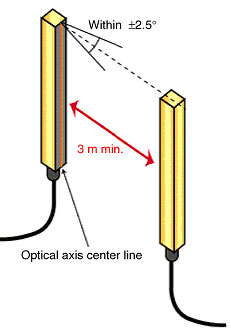
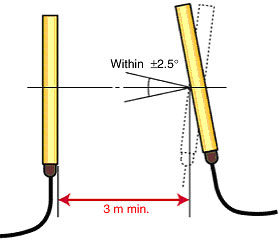
Table of OMRON Safety Sensor/Safety Curtain Effective Aperture Angles (Directional Angles)
What is FMEA?
FMEA stands for failure mode and effects analysis and is a method for analyzing failure modes and their effects.
Safety design is based on FMEA data to help ensure complete safety.
With Type 4 Safety Sensors, it is proven that danger will not arise after one malfunction, and danger will not arise after up to 3 malfunctions not detected by a self test, self-diagnosis, etc.
How do you release lockouts with F3SN/F3SH series Safety Light Curtains?
The following two methods are used for releasing lockouts.
1.Cycling the power.
2.Applying a reset input.
Auto Resetting
Apply 24 VDC via a NC reset input switch.
Manual Reset
Apply 24 VDC via a NO reset input switch.
What is a safety distance?
Minimum Distance from the Detection Zone to the Danger Zone
The safety distance is the minimum distance that the Safety Sensor must be separated from a hazardous section in a machine in order to stop operation of the hazardous section before a person or object reaches it. The method for calculating this safety distance depends on the standards for each country and the standards for individual machines, so always refer to the relevant standards before using machinery.
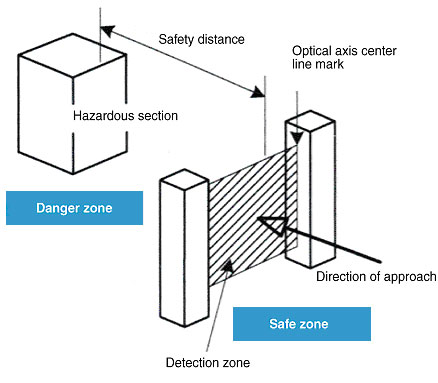
Why are control outputs of the Short-range Safety Light Curtain "F3SN/F3SH" are defaulted as the Light-ON outputs?
From a fail safe point of view, Safety Sensors/Safety Light Curtains require to be designed so that a guarded machine will not perform dangerous operation when any malfunction or failure occurs.
In the Light-ON output mode, the operation part of the machine is through the contact point of the Relay.
Thus, even when current does not flow due to malfunction or failure, the contact point a goes in the open state and the machine does not operate, or the machine performs safe operation.
On the other hand, in the Dark-ON output mode, the operation part of the machine is through the contact point b of the Relay. Thus, when current does not flow, the contact point b goes in the close state and the machine operates, or the machine may perform dangerous operation.
Therefore, Safety Sensors/Safety Light Curtains adopt the Light-ON output mode in consideration for safe use.
What is the difference between F3SN/F3SH Series Safety Light Curtains and F3W Series Line Sensor?
F3SN/F3SH series conform to safety system construction for any category but other F3W-series, F3WN-series Area Sensor for Workpiece Detection, and F3ZN-series Area Scanner for workpiece detection cannot be used in constructing safety systems.
In practical terms, the safety of systems is ensured with F3SN/F3SH series mainly because these products have the following four functions.
F3W-series and F3WN-series, on the other hand, do not have the design features listed under 1 to 4 below, so they cannot be used in safety applications.
Main Functions of F3SN/F3SH series
1.The Sensor itself regularly performs diagnostic checks.
Self tests for F3SN/F3SH Series
2.The Sensor itself detects external malfunction factors (e.g., noise and external light interference) in addition to malfunctions.
3.The Sensor has a failsafe design to always ensure a safe status (control outputs OFF) even if the Sensor is malfunctioning.
4.The control outputs always use light-ON operation.
On the other hand, the potentially dangerous option of dark-ON can be selected for F3W-series, F3WN-series, and F3ZN-series.
What is the self-diagnostic function?
The self-diagnostic function checks for errors in Safety Sensors.
Self-diagnosis occurs when the power is turned ON (within 1 s) and periodically during operation.
This function is called self testing for F3SN/F3SH Series Safety Light Curtains.
Applicable models:
F3SL Series Safety Light Curtain
F3SS-AT60P Single-beam Safety Sensor
What is the protective height?
The protective height is the range in which an object can be detected.
With F3SN-A-series Safety Light Curtains and F3SN-B-series, extra space can be minimized by making the protective height and sensor length the same, as shown in the following diagram.

What is the smallest detectable object for F3SN series Safety Light Curtain?
The smallest detectable object is one of a size that will always break the Safety Light Curtain beam at any point in the Safety Light Curtain protective height.
Specifically, the smallest detectable object is a non-transparent object as big as the optical axis pitch plus the lens diameter, as shown in the following diagram that will break the beam at any point (position).
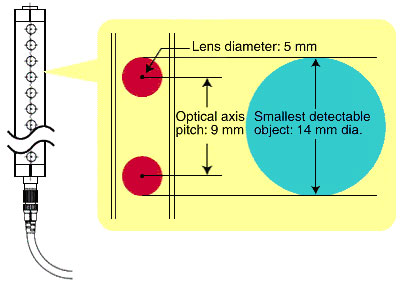
What is the muting function?
The interlock function sets an interlock under specific conditions. (An interlock is when the machine operation is stopped and, for Safety Light Curtains, control outputs are turned OFF.)
OMRON Safety Light Curtains have functions which use the interlock state and others that do not use the interlock state, as outlined below.
Auto resetting does not use an interlock. In other words, after the power is turned ON and the Sensor beam is interrupted, the control outputs will automatically turn ON when light is incident on the Sensor.
Applicable models:
F3SN Series Safety Light Curtains
F3SH Series Safety Light Curtains
In an interlock, the Sensor will hold control outputs OFF and control outputs will not turn ON even if light is incident on the Sensor. The interlock is cleared and control outputs turn ON only after light is incident on the Sensor, equipment safety has been confirmed, and a reset input has been applied.
F3SN/F3SH Series has the following three modes.
(Sensors are set to use the start/restart interlock when shipped. The setting can be changed by using the F39-MC11 Setting Console.)
The Safety Sensor is interlocked when the power is turned ON and the Sensor beam is interrupted.
The Safety Sensor is interlocked only after power is turned ON.
The Safety Sensor is interlocked only when the Sensor beam is interrupted.
Applicable models:
F3SN Series Safety Light Curtains
F3SH Series Safety Light Curtains
What are Type 2 and Type 4?
There are two types of Safety Light Curtains that are compatible with IEC 61496-1 and IEC 61496-2.
Type-2 Safety Light Curtains can be used for systems in categories B, 1, and 2. Type-4 Safety Light Curtains can be used for all categories.
What is an auxiliary output?
The default setting of the output is the reverse signal of the control output. It is only an auxiliary output, so do not use it as a control output for a safety circuit.
For F3SN-A and F3SH Series, the output operation mode can be selected using F39-MC11 Setting Console.
1.Dark-ON output = Control output and its reverse signal (default setting)
2.Light-ON output = Synchronized with the control output
3.Light diagnosis output
4.Lockout output
5.Outermost-beam monitoring output
6.Specified-beam output
7.Blanking monitoring output (F3SN-A only)
What is a manual reset?
A manual reset is a selectable feature of the interlock function.
When the Safety Sensor enters the interlock state, it keeps the control outputs in the OFF state. Even if all beams become free, the control outputs will not go to the ON state.
When none of the beams are interrupted in the detection zone and it is safe to operate the device, applying the reset input will reset the interlock condition and the control outputs will go to the ON state.
Applicable models:
F3SN Series Safety Light Curtain
F3SH Series Multi Beam Safety Sensor